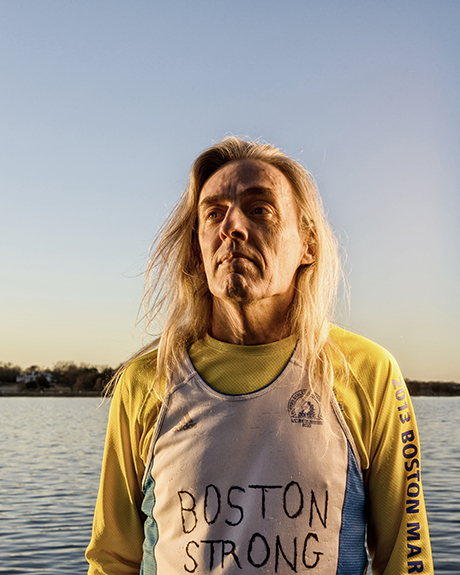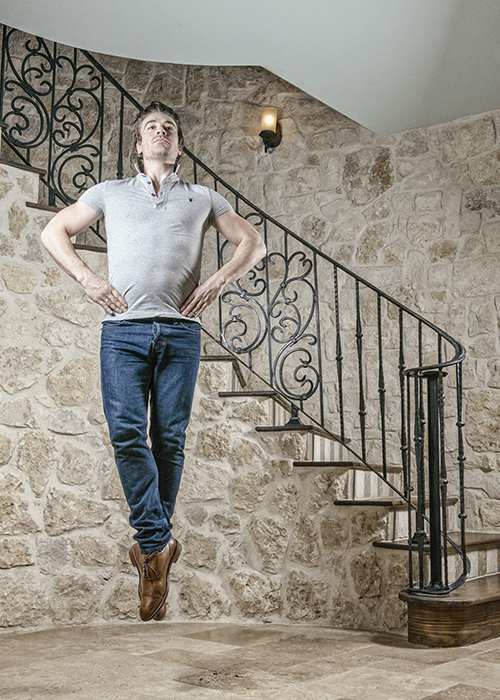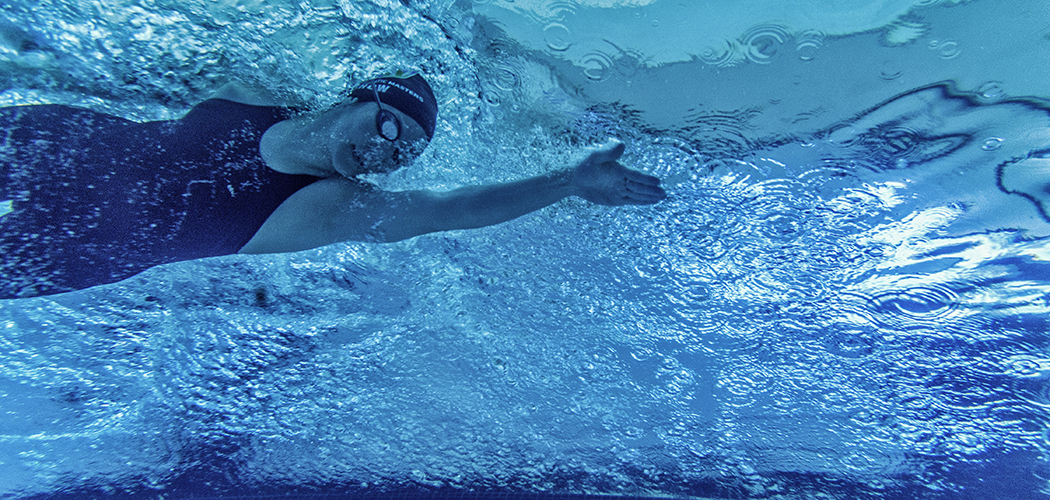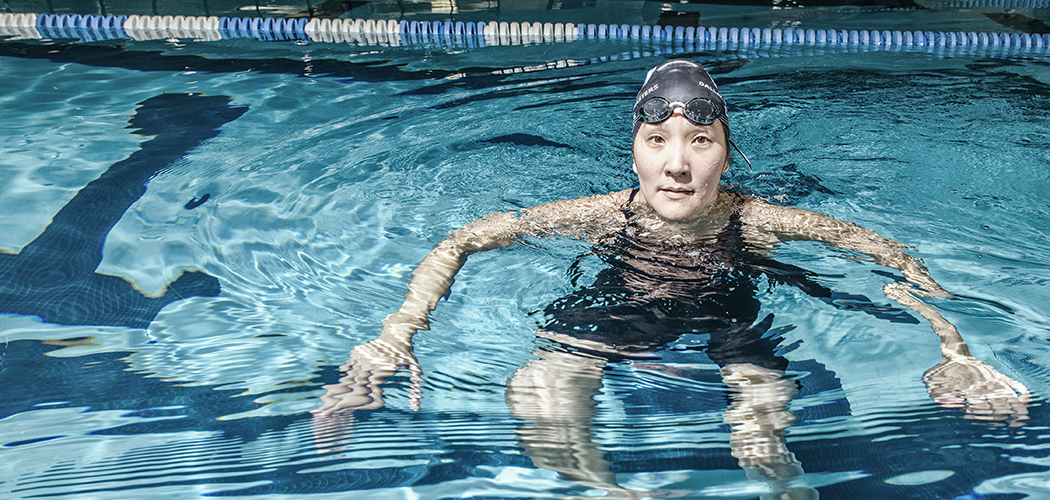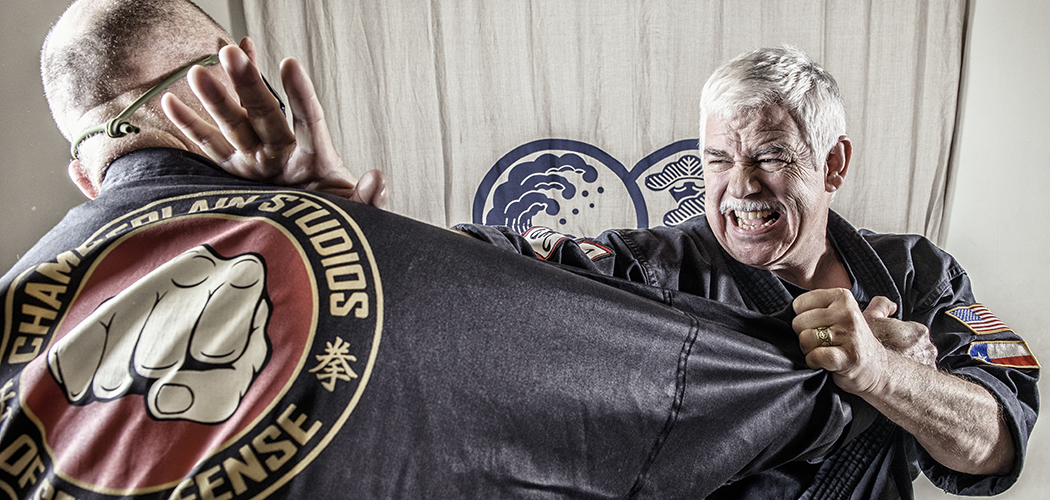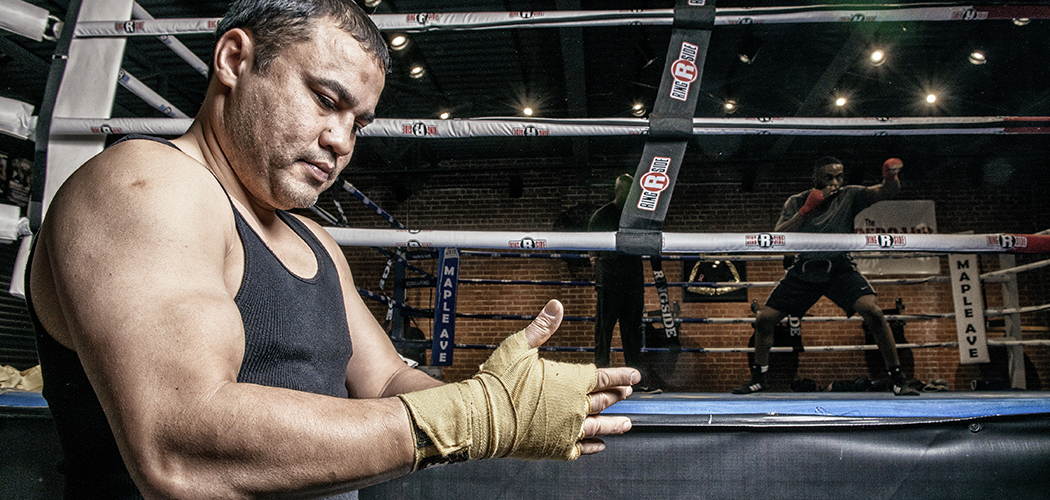Physical activity is critical for health, but for these East Dallas neighbors, their obsession runs deeper. They feel most alive with the pounding of footsteps, the beads of sweat and the competitive drive that comes with athletic prowess. So lace up, stretch out and read up on how fitness changed these local residents’ lives.
Run for your life
Ron McCracken has run more than 6,000 consecutive days. To him, it is therapy, and also kind of an addiction. He runs because he can’t stop.
“It’s no exaggeration to say that running saved my life many times,” he says.
You might’ve seen him at White Rock Lake, jogging along the trail in a once-white shirt with the words “Boston Strong” handwritten in pen on the front, holding a tattered American flag in his right hand.
People often salute the flag as he passes by, he says. His favorite encounters are when Marines give him a traditional “Ooh-Rah!”
He plans to run his 16th consecutive Boston Marathon next month, even though he still carries emotional scars from the 2013 bombing.
McCracken became enamored with running when he was just shy of 10 in the summer of 1972. While watching the Olympics, he saw Frank Shorter, an American long-distance runner, take the gold medal.
“I was just riveted,” McCracken says. “I still remember when he entered the stadium just thinking, ‘This is the coolest thing ever.’ He inspired a lot of people.”
The very next day McCracken asked his mom to measure a mile around the neighborhood, and he started running. A year later his mom bought him a stopwatch, and he pushed himself to run faster and faster.
As a freshman he was involved in basketball, but he “was having a miserable time,” he says, because the coaches weren’t the mentor-type figures he wanted. “They had their favorites, and I wasn’t one of them,” he explains. “On my own I would practice probably 40 hours a week, and I could see where it was going; it was tearing me up.”
He left the basketball team to pursue running. His dream was to become a world-class miler, but he soon realized he’d never run a 4-minute mile.
“No matter how bad I wanted to, my body wasn’t designed that way,” he explains. “I realized early on that the longer I ran, the better it was for me.”
“I left it at home one day and a couple different people I don’t even know asked me, ‘Where’s your flag at? We love seeing you run with the flag.’ I love that people get it. It’s a symbol of defiance that ‘You won’t stop us.’ ”
But the real difference was the mentoring he received from his coaches. His parents had separated a couple years earlier, and he was desperate for a father figure.
“Those were the men I needed,” he explains. “They were very positive. My freshman year, compared to other track runners, I was kind of in the middle. I was mediocre. After a tough race, my coach would come up to me and put his arm around me and say, ‘That was a tough race, wasn’t it?’ I needed that.”
As a teen, McCracken struggled with severe depression, which he still battles today.
“I’ve always been a very emotional person. Every single day I was angry as hell,” he says, “but running kept me out of trouble. If I didn’t have running, I would either be dead or in jail — probably both. I’m serious. There’s no doubt I’d have been dead a long time ago if it hadn’t been for running. I probably would have ended up killing someone. That might sound disturbing to some people, but that’s just the truth.”
Luckily, his coaches recognized his need for an outlet. Even though he wasn’t always the easiest student to coach, they stuck by him.
He graduated high school and went on to study at the University of North Texas running cross-country, but he and the other players dealt with constant injuries because of the intensity of the team’s workout regiment. Even as a young man, McCracken knew he wanted to run for the rest of his life and he was afraid the injuries would ruin him. So halfway through the season, he left the team.
He never stopped running, but it wasn’t until 1992 that he explored his first marathon. Although he was warned by experienced distance runners to pace himself at the beginning, he underestimated how hard the last 6 miles of a marathon would be if he didn’t, which resulted in a disastrous finish. “It was so bad,” he remembers. “I couldn’t believe how badly I’d misjudged it.”
It shook him up enough that he didn’t run another marathon until 1998.
McCracken ran his first Boston Marathon in 2000, and he has run it every year since, even though the race is linked with more than one dark memory.
In 2005, his best friend died the day after the marathon.
“I didn’t find out until I flew back,” he says as his eyes pool with tears. “The first call I got when I got back was that one. It was very sudden and unexpected. He was 40.”
Then in 2009, McCracken’s mother passed away, also suddenly and unexpectedly, while he was in the air on the flight home.
“I called her from the running store before I left for the airport,” he says. “She was at work and I asked her how she was doing — had a little conversation. So you can imagine, at 7 a.m. I get a phone call that mom’s dead. That can’t be right. I just talked to her.”
Combined, those two experiences gave him “a borderline phobia” about the Boston Marathon, he says. “The two biggest people in my life, I’m flying back from Boston and they die? I was unprepared in every way.”
But he kept running the Boston Marathon anyway, partly for himself and partly out of respect for his mom, who was his biggest fan and supporter and who adored the event, he explains.
Then he was there at the infamous 2013 Boston Marathon, which ended abruptly when two brothers set off a homemade bomb at the finish line, killing three people and injuring 264 others.
McCracken remembers that day vividly, how hundreds of emergency vehicles packed the street for miles and the National Guard wouldn’t answer his questions: What happened? Were people hurt? He remembers reaching out and touching an ambulance as it drove by.
“That was a really dark day,” he says. “For a lot of us that was a huge turning point in our lives. In the hours after it, even though I didn’t understand the full gravity of it, I remember wandering around Boston and I just thought, ‘This can’t be good for us. This can’t be good for our souls.’ ”
He returned home and a couple of days later, while running near White Rock Lake, an ambulance drove by him along Buckner. When the siren clicked on, McCracken was propelled into the throes of a panic attack, a classic sign of Post Traumatic Stress Disorder.
That’s when he started running with the American flag.
“I knew I needed something,” he explains. “When I’d run by veterans they’d salute the flag, and that really touched me. I left it at home one day and a couple different people I don’t even know asked me, ‘Where’s your flag at? We love seeing you run with the flag.’ I love that people get it. It’s a symbol of defiance that ‘You won’t stop us.’ ”
He knew he had to go back to Boston. Like thousands of others, he went back the next year to reclaim the finish line.
“It was extremely important — to everyone,” he says. “Leading up to it, people would always ask me, ‘Are you scared about going back?’ and I would say, ‘It doesn’t matter. We have to.’ ”
But it hasn’t been easy.
“I still cry about Boston every day,” he says. “I think I always will.”
Jig into it
“Do you ever just think about those moments that really define your life?” Kincaid Stringer muses.
He was 7. And, of all things, it was “Riverdance” that captivated the young boy’s imagination, and would ultimately define his life.
His parents, East Dallas neighbors Shannon and Allen, returned home from Ireland with a “Riverdance” DVD, and Stringer watched it obsessively. That was 20 years ago — the first year the now world-famous show began.
“‘Riverdance’ is what made Irish dancing globally famous,” Springer explains. “[Choreographers] Michael Flatley and Jean Butler made Irish dancing sexy.”
A year later, the show toured through Dallas, and Stringer watched wide-eyed from the audience as the dancers on stage, bodies rigid and heads held high, rapidly moved their feet to create a rhythmic percussion. Each dancer displayed beauty, grace and strength, and Stringer was hooked. He knew exactly what he wanted: to be in “Riverdance.”
He began taking Irish dance classes at St. Thomas Aquinas Catholic School in Dallas. A natural athlete, Irish dance was everything Stringer hoped it would be.
“It’s right-brained and left-brained. It’s as mentally stimulating as it is physically challenging,” he explains. “There are a lot of technical aspects of it — the composure of your body combined with the speed of your legs, and then there’s the rhythmic musicality of what you’re performing. It’s so athletic but so artistic. I’m obsessed.”
Over the years he traveled back and forth from Dallas to Ireland to train and compete. While in Ireland, he lived with the family of “Riverdance” cast member Celine Hession, who became like a second mother to Stringer.
“I trained with them every year, and don’t think I realized until I was like 15 or 16 years old that we aren’t blood related,” Stringer says, in a distinctly Irish accent. “Their daughters are like my sisters.”
“There are a lot of technical aspects of it — the composure of your body combined with the speed of your legs, and then there’s the rhythmic musicality of what you’re performing. It’s so athletic but so artistic. I’m obsessed.”
By college he was one of the top Irish dancers in the world. He eventually moved to Ireland, leaving his studies at the University of Texas to study literature and business at National University of Galway in Ireland — all while competing in dance. He won more than 10 regional titles, the All-Ireland title twice, the All-Scotland and The Great Britain Championships. He almost won the World Championship, reaching fourth place in the world, before he retired from competing.
“I have one of those tragic ‘I-almost-did-until-I-didn’t’ stories,” he says dismissively.
“The year I was closest to winning the world title, I was leading. You do three rounds and I was leading after the first two. I danced really well, and at the very end I slipped and fell. There was a ridge in the floor, and afterwards they pulled up the floor and fixed it, but then didn’t let me go again. You win some, you lose most.”
Those near-misses all lead to his big break in 2011, when the official “Riverdance” troupe began a search for a new cast member. Out of thousands of people who sent in DVDs, he was selected for a live audition.
“It was what I always wanted to do,” he says. “So we went, warmed up and there were all kinds of world champions there. It was intimidating. We all knew each other, but this was going in for a potential job.”
The audition only lasted about 20 minutes and then he was dismissed. A few weeks later, while in Barcelona, Spain, for his sister’s 18th birthday, he received a call.
“They said, ‘Congratulations, you’ve passed the audition. We’re giving you a spot.’ They didn’t take anyone else,” Springer recalls. “It was my sister’s 18th birthday, I’m supposed to be this big brother and I’m like weeping in the hotel and my dad’s crying in the corner. It was cool.”
Not long into touring, “Riverdance” did a North America tour. After a six-weeks in California, Stringer found himself in the exact venue in Dallas where he first saw the show as a boy.
“That was nuts,” he remembers. “I was standing on the stage and I could see my mother, and I thought, ‘It was 20 years ago that I was sitting there watching this show, and now I’m here performing for them.’ It all came full-circle.”
Beyond North America, “Riverdance” has taken him from South America to Europe to Asia to Africa. While glamorous, it’s a life that many of his friends don’t find relatable. He relishes the opportunities he’s had, “but I live out of a suitcase, I don’t have a mortgage and I’m definitely not getting married anytime soon,” he says with a chuckle. “So it can be hard when I come home to connect with people.”
However, the friendships he has made along the way have made up for it.
“When you go on tour your friends become your family,” he says. “There’s this hodgepodge of people and you never get to be alone — ever. Everybody has rooms and all that, but you don’t just travel with people, you live with people 24/7. The best alone time you have is when you’re in the shower.”
When Stringer thinks about all the things he wouldn’t have if his parents hadn’t introduced him to Irish dancing as a 7-year-old, it’s staggering.
“I wouldn’t have a career,” he says. “I wouldn’t have the friends I have. I probably wouldn’t have gone to university in Ireland, although I might have. I wouldn’t have traveled and seen the world. If I wasn’t a dancer, I don’t know what my life would be.”
His home base is his parents’ house in East Dallas. On top of touring, he teaches Irish dance workshops to kids all over the world. He plans to always keep a foot in Irish dance.
“That way I can get my fix and do all the other things I want to do too.”
Pedal power
Although Heather McRae has been dealing with Multiple Sclerosis (MS) daily for more than 20 years, she never connected with other people in Dallas with MS. Instead, they cycled up to her.
The first time McRae went to a Meat Fight event, which is an annual barbecue in Dallas that raises funds for the National MS Society, she was skeptical.
“The first year on the way to the event I remember telling my husband, ‘It’s really weird going to an event that’s about a disease I have,’” she says, “but when I got there it wasn’t like that at all. It was so uplifting and empowering. They want to help us find a cure, but not because they think we’re sad people. It’s about drinking and barbecue. It’s about MS, but you don’t feel like it.”
That’s probably because the founder Alice Laussade created the event to help her own brother, who also has MS. Through mutual friend Marta Sprague of Noble Coyote the siblings met McRae and she was convinced to join their Meat Bike team.
Meat Bike, which is an offshoot of Meat Fight, provides people with MS with a brand new road bike from Richardson Bike Mart and a full cycling kit — Spandex, helmet, shoes and more. The purpose is to get active because cardio can lessen the symptoms of MS. In return, the participants agree to cross the start line at any bike MS event.
“I was like, ‘Oh wow, I haven’t ridden a bike since I was 14, so I don’t know,’” McRae remembers.
As McRae thought about it, she remembered how much she loved riding her bike as a kid, and she did need the exercise, so she figured, “Why not?”
She signed on, and she and Sprague began riding together at White Rock Lake. She also began riding with other Meat Bike team members, and for the first time met other people with MS.
“Before I wasn’t exercising and putting myself out there,” she says. “I wasn’t even meeting other people with MS. I was just living with MS, so getting this bike was really some of the best medicine anyone has every prescribed to me.”
“It’s a part of my life, and it’s healthier to have it out there and talk with other people who have MS.”
At first she only rode a few miles at a time because she was nervous about falling. MS affects balance, fatigue, nerve pain and sparks muscular symptoms like cramping, stiffness and difficulty with coordination.
“I was afraid it would make me feel worse,” she explains. “But it didn’t and I was able to ride more and more. It was exciting that I could even accomplish that, and it actually gave me energy and I’m stronger from it too.”
In 2015 McRae rode in her first long-distance ride, and she made it 77 miles — something she never dreamed possible.
“The most I’d ridden before that was 22 miles,” she points out. “I never would have even entered if it wasn’t for Meat Bike.”
She plans to race again and hopes to ride longer distances each year. McRae has made Meat Fight and Meat Bike two of her passions. As the team adds new riders, the older riders become mentors, she says. Although the focus is more on socializing and exercise, as a byproduct, she’s become more comfortable discussing MS.
“It’s a part of my life, and it’s healthier to have it out there and talk with other people who have MS,” she explains. “So as you’re riding and things come up, like if you can’t feel your feet one day, it’s easier to talk about it with people who also have MS. It makes me realize, ‘OK I don’t have to hide from this and keep it in the background.’”
Stroke of luck
When Michelle Chow was first introduced to competitive swimming, she was terrible at it.
Her parents immigrated to the United States from China under the quota system during World War II.
“So their whole life was very, very different,” she says, explaining that her mother pushed her toward the pool. “She really wanted us to be physically active, so she put us in a summer league swim team.”
Chow’s older brother and sister were both very gifted, and soon coaches noticed her siblings and tried to recruit them to USA Swimming, which was called AAU Swimming at the time.
“I remember [the coach] came to our house, and my mom said, ‘OK, we’ll join this year-round team, but you have to take Michelle,” Chow recalls with a laugh.
And lucky for her, he did. Over time she got better and better, and by 12, she was really good.
“As with any athlete, to triumph, you have to have the physical gifts, the drive and determination, the opportunity and the support,” she explains. “So I don’t know how it happened that they picked the right sport for me, and that I liked it so much that I was driven, but I was. Being on time was late to me.”
Her dad, an engineer, built Chow a swim bench that allowed her to do dry land swim training at home, “and I just did that religiously,” she says. “I was one of those kids.”
It showed. In high school, she won the Pennsylvania State Championships every year she was eligible. During high school, swimmers can only set two individual events per year, so the maximum events swimmers can win is eight.
“So that’s what I did,” Chow says. “My claim to fame is that I set the eight-for-eight unbreakable record.”
And so far nobody has tied it.
“I was third in the nation in high school rankings, and that opened up a whole bunch of opportunities for me — just the highest that were available,” she says. “I didn’t appreciate it at the time, but I got full scholarships from everybody. I wish I’d kept those letters.”
She decided on Texas A&M University with a full swimming scholarship. It was a time that challenged her perfectionist nature.
“I didn’t get all the things I thought would just happen,” she explains. “I always thought that equation of: work hard, train well and compete equals success. At the time, it was the most devastating thing when that didn’t happen.”
She qualified for the NCAA, which only about 30 women make each year, but she didn’t place individually. She also qualified for the Olympic trials, “but I wasn’t really a contender,” she points out.
“But I had some successes. I was one of those people who made the highest qualifications, but I didn’t actually place or make a national team,” she says. “I was just kind of like a bridesmaid, but it taught me a lot about finding meaning in where you are and at the level you are.”
Plus, all the hard work paid off when she was looking for a job and potential employers were looking for that extra thing that set her apart as a candidate.
“That helped me tremendously, especially once I went to business school and started interviewing at investment banks,” she says. “They wanted ultracompetitive people, and that’s what helped me get my job at Goldman Sachs, which back then was the best job you could get. So that’s the thing that I think really changed my life.”
After college she only took a year off before she started U.S. Masters Swimming. She was almost as fast as she was in college, so she set two world records right away.
These days, she doesn’t have as much time to train, so she’s intensely focused when she swims — always thinking about her technique and what she could do better.
Between work and raising her two daughters, swimming gives her extra balance and a sense of self, she says. “When you look at the clock, you know exactly who you are to a hundredth of a second.”
Radio star
As a teen, Allen Stone’s journey with sports was primarily intellectual. He liked all aspects of heady sports culture from history and statistics to human-interest stories and its cultural underbelly.
Although he didn’t set out to become a sportscaster, his interest took him from radio to TV broadcasting to pubic relations and beyond.
He did the morning broadcast on WRR-FM, which is now The Ticket, but when the show lost its sports anchor, he was asked to step up to the plate while also doing the news.
“Since I had a sports background, it was so easy for me,” he explains. “I went to them and said, ‘I’d really rather be the sports director,’ so I did.”
From there Stone caught a lucky break and managed to land a job as the weekend sports anchor at Channel 4, even though he had no previous TV experience.
“Then I got hired by the Dallas Mavericks when the franchise first came together,” he says. “I was one of their original employees, which quickly moved me into public relations and broadcast. I went back on the air as the Dallas Mavericks’ main TV announcer for 13 years.”
He left the Dallas Mavericks in the early-‘90s to work for ESPN part-time, but he needed some extra work. As an SMU grad, he found out the school was looking for a play-by-play basketball announcer.
“I thought, ‘Oh that would be fun, my alma mater. I’ll do that for a while until I figure out what else I want to do long-term,’” he recalls with a chuckle. “My mindset was, ‘I’ll do this for a season.’ That was 23 years ago.”
He shuffled through other jobs, but he always kept the SMU basketball gig, he says — although he shifts back and forth between being a play-by-play announcer and the guy who adds color and trivia to the show. When he retired last year, it freed up his schedule to allow him to spend even more time announcing games at home and away.
“Obviously getting into sports opened a ton of doors for me,” he says. “I got to do a lot of things, but I don’t see myself as a sports addict,” he says. He doesn’t want his life to be “dominated by sports,” but rather something he does for his own personal enjoyment.
“I’ll turn 70 in August, and I keep thinking SMU is going to get rid of me anytime now,” he says. “Or I’ll think, ‘Now that I’m retired I should probably give it up,’ but I’m having so much fun right now because SMU is doing so good. I did it for so many years when they were bad.”
And he figures since SMU’s basketball coach Larry Brown is 75-years-old, maybe that’ll buy him some extra time.
“Because I’m not that old,” Stone says.
Body and balance
While many high school students were partying, Nick Chamberlain earned his black belt.
What started as a hobby soon became an obsession and a career that provided him with an identity, a culture and a family.
Chamberlain joined karate at age 15, shortly after moving to Boston from England because he didn’t know any other American sport. He liked that karate let him determine his own success.
“I enjoyed sports where you could make the difference yourself,” he says. “Karate is an individual sport. If you want to get better, you have to work harder.”
Once he started karate, it was “consuming,” he says. “I spent two or three hours most nights of the week at the karate studio, doing classes and private lessons, training with the other guys.”
Chamberlain started assisting the teachers long before he got his black belt. When he graduated high school he was faced with a decision of what to do next: he could go to school to study business or launch a karate studio.
He decided to continue teaching karate, so his parents sold their home and helped him open a franchise martial arts school.
“That’s how I got started,” he says, but he continued to search for new opportunities as well. He considered law school but then quickly became disenchanted with the idea when he realized practicing law wouldn’t afford him the work-life balance he wanted.
“I knew several attorneys who were working 80-90 hours a week, and their families thought they were the guy who came over on Sundays to play baseball,” he quips. “I had two dads who brought their kids to karate — everyone else was brought by their moms. I asked those guys, ‘What do you do that allows you to bring your kids to karate?’ Both of them were chiropractors.”
So that settled it. He moved to Dallas to study chiropractic care, and he continued to study and teach martial arts to pay his way through school. He founded Chamberlain Studios of Self Defense in Lakewood, and today he teaches hundreds of kids and adults in East Dallas.
Through his education, he met Kimberly Jones, who was also studying chiropractic care in Dallas. They married shortly after graduation. While both sought a life that put family first, they were disheartened to learn that family would be difficult to build.
“We tried to have kids,” Chamberlain says. “We didn’t take extraordinary measures like going through IVF and all that, but we tried for a few years and it didn’t work out.”
Although martial arts doesn’t take the place of family, it helped fill the void in some way because “having time and family and community and all those things was important,” he points out.
“We’ve created a martial arts family where everyone cares about each other and cares about the success of others. I run the school as a family community,” he explains, and then jokingly adds, “and it is nice to work with some really cute kids and then send them home.”
In his studio he teaches Kenpo, a version of mixed martial arts, but over the years he has trained in various forms of martial arts. Last year Chamberlain received designation as Grand Master and the rank of 10th degree black belt at the Kenpo International Hall of Fame.
“That’s the beauty of martial arts. In most sports, once you hit your 30s or 40s you’re done, you retire,” he explains. “Whereas in the martial arts, as you get older, people are like, ‘Oh you must really be good. You must really know what you’re doing.’ You get wiser. You can keep practicing as long as you want.”
It has given him an opportunity to travel and learn by immersing himself in other cultures from Hawaii to China. He also realized more and more how much he loves teaching and helping people, and how much his work with martial arts spills over into his work as a chiropractor.
“For me being a doctor is the same,” he says. “It’s teaching people about diet, nutrition, stress-reduction and exercise routines. It’s very closely tied to the physical work you do in the martial arts. There’s a crossover.”
He and Kimberly both practice chiropractic care in a room above Chamberlain’s martial arts studio in Lakewood.
Fighting for his life
Though he’s only 5-feet-5, Jesús Chávez is known in certain circles as “El Matador” or “The Killer.” It’s an appropriate name for a boxer, especially one of his caliber. During Chávez’s career as a lightweight fighter, he won 44 of 52 matches and garnered two world titles. But his rise to glory was far from smooth.
In the summer of 1990, when Chávez was 16 years old, he was arrested for armed robbery. He says he was an accomplice mixed up in the wrong crowd. It was his first offense, but he spent the next four years behind bars.
“When I was there I swore I was never going back to a prison or a jail cell,” he says. “But I knew about my immigration problem.”
The “problem” was that Chávez’s family moved from Chihuahua, Mexico to the United States when he was a child. They had been granted amnesty, but Chávez’s arrest meant he’d violated the terms of his immigration status. At the end of his sentence, he was immediately deported.
“There I was, with $50 in my pocket, in a place where I had never been — Mexico City,” he remembers. “I basically hitchhiked my way back to Chihuahua and lived with my grandparents.”
Mexico was unfamiliar to Chávez. The United States was the only home he knew. After a couple months he “walked straight through the line,” boarded a plane and flew to Illinois. He says it was easy, probably because his English was perfect.
Chicago proved difficult. Chávez got calls from former friends who had become bad influences. Not wanting to get embroiled back in crime, he decided to move, at the suggestion of his father, to Austin, Texas.
It was there that he met Richard Lord, who owned a local boxing gym. Lord recognized Chávez’s talent and let him train and live in the facility. Pretty soon he had a promoter and was fighting against some of the biggest names in the industry.
But then he applied for a driver’s license.
“I didn’t have the right documentation,” he explains. “The only reason they didn’t deport me right away was I had a major promotional contract in the US so I was conducting business here.”
Eventually, Chávez voluntarily deported himself. He figured he’d be in Mexico for six months tops. He was there for four years. During that time, he prepared for a fight against Julio Alvarez, one of Mexico’s top boxers. The men were friends but things turned ugly before the fight.
“His supporters paid off the chef where I used to eat,” Chávez says. “I was getting stomachaches and had to postpone the fight.… They were putting barbiturates in my food.”
The foul play was documented in “Split Decision,” a 2002 film that chronicles Chávez’s struggle to return to the United States.
“I agreed to do [the documentary] for educational purposes,” he explains. “It’s educational for a lot of different people, like at-risk kids, and it has a lot of good information regarding immigration law.”
Chávez won his match against Alvarez. He says it was the only time in his career he was “intentionally trying to hurt someone in the sport of boxing.”
Then, in 2001, he secured an even greater victory. With the help of his attorney, he was allowed to return to Austin — this time, legally.
After four years of relative peace, his world would come crashing down again.
On Sept. 17, 2005 he fought Leavander Johnson, for the lightweight world title. Chávez won. But after leaving the ring, Johnson collapsed in the locker room, and later died from a brain injury received during the fight.
“I felt horrible,” Chávez says, tearing up. “I blamed myself for a long time. The only people who could help me get out of that rut were [Leavander’s] family. They asked me to come to the funeral. I agreed and I flew out there. They understood the risks and they said, ‘Keep fighting. Do it for Leavander.’”
Chávez kept fighting another four years, but he also began exploring other interests. He volunteered with the Austin Police Department, teaching boxing to at-risk kids, and developed a passion for social work. In 2010, he met Arnie Verbeek, who owns Maple Avenue Boxing Gym, off Inwood Road. The two became close.
Verbeek offered Chávez a job managing the facility, so he moved to East Dallas. That’s how he discovered Café Momentum, a nonprofit restaurant that provides culinary training to teens who have served time in juvenile detention facilities. Chávez couldn’t resist putting in an application. He was hired immediately and now works as a case manager.
“The kids I work with are all really good kids in bad situations,” he says. “They ask me about my past. Some have seen the documentary and it’s interesting to them. They say, ‘You must have made a lot of money.’ They think I’m rich.”
Chávez tells them he’s experienced extreme highs and extreme lows and advises them to stay out of trouble and pursue their passions. He can’t imagine where he’d be without boxing.
“After all of the hardship — the incarceration, the deportation — I know I was great at something,” he says. “I was one of the best in the world. Not many people can say that. I’m proud. Now I’m a social worker and I’m proud of that too. I’m giving back.” — Elizabeth Barbee


